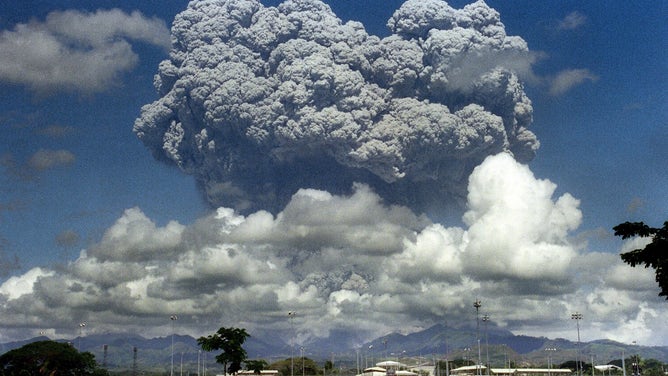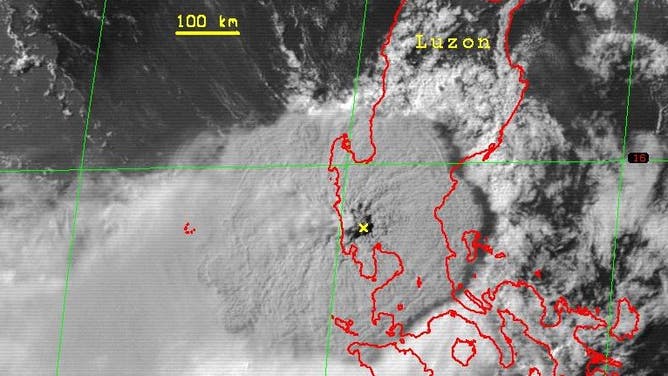On this day in 1991: One of the largest volcanic eruptions of the 20th century
The eruption was accompanied by small earthquakes. Plus, during the eruption’s peak activity, a typhoon struck within 50 miles of the volcano.
Watch: Lava flows from the Mayon Volcano in the Philippines
Video shows lava flowing from the Mayon Volcano in the Philippines as thousands of people are forced to flee their homes.
ANGELES, Philippines – On June 15, 1991, the eruption of Mt. Pinatubo in the northern Philippines became the second-largest eruption of the 20th century and the largest one to affect a densely populated area.
Located northwest of Manila, Mt. Pinatubo had lava oozing from its surface beginning on June 7, 1991, said the U.S. Geological Survey. The situation escalated on June 12, when millions of cubic yards of gas-charged magma reached the surface of the volcano and culminated in an explosion on June 15.

Map showing the location of Mt. Pinatubo in the Philippines.
(FOX Weather / FOX Weather)
According to NOAA, Pinatubo erupted with a Volcanic Explosivity Index of 6, making it the second-largest eruption of the century. For reference, the deadly Mt. St. Helens eruption of 1980 was a VEI of 5.
What happened during the eruption

A giant volcanic mushroom cloud explodes from Mount Pinatubo on June 12, 1991, followed by another more powerful explosion on June 15, 1991.
(ARLAN NAEG / AFP / FOX Weather)
The eruption of Pinatubo produced pyroclastic flows, which are a mixture of rock fragments, gas and ash that rush tens of meters per second, and lahars, which are a mixture of water and volcanic debris that quickly move down the volcano, according to the USGS.
THOUSANDS WHO FLED THE MAYON VOLCANO IN THE PHILIPPINES MAY STAY IN SHELTERS FOR MONTHS
They added that the eruption ejected more than 2.4 cubic miles of magma and produced an ash plume that reached more than 28 miles high.
According to NOAA, a layer of ash that was two inches or thicker covered a land area of more than 1,500 square miles – or nearly five times the size of New York City. This ash burned and destroyed crops and other plant life near Mt. Pinatubo.
How a typhoon and earthquakes made matters worse
During the peak of the eruption, the storm Typhoon Yunya arrived within 50 miles of the volcano and helped spread the ash produced by Pinatubo throughout the region.
The typhoon also saturated ash with rain, which accumulated on many homes. According to the USGS, many of the fatalities came from roofs collapsing under the weight of wet ash.
Additionally, thousands of small earthquakes were detected beneath Pinatubo in early June and in the months leading up to the eruption, the USGS said.
The eruption caused 847 total deaths and cost about $700 million in damage, the USGS added. Hundreds of thousands of Filipinos became homeless as a result of the eruption.
How Pinatubo changed global weather

Satellite image of Mount Pinatubo eruption cloud about 2.25 hours after the onset of the climactic phase of the eruption, June 15, 1991. The yellow 'x' marks the volcano. The enormous round shape of the eruption cloud resulted from the pass of tropical storm Yunya across the Philippines about 75 km northeast of Pinatubo during the eruption.
(USGS / FOX Weather)
Outside of the Philippines, the eruption of Mt. Pinatubo affected the weather around the world.
According to NOAA, large quantities of particles from the volcano’s ash cloud were injected into the global wind system in the stratosphere. This caused a maximum global cooling of about 1.5 degrees Celsius and led to a reduction in the density of the ozone layer in the stratosphere.
According to the Smithsonian Institution Global Volcanism Program, Mt. Pinatubo was a relatively unknown volcano by the 20th century. Its last known eruption occurred in 1315.



